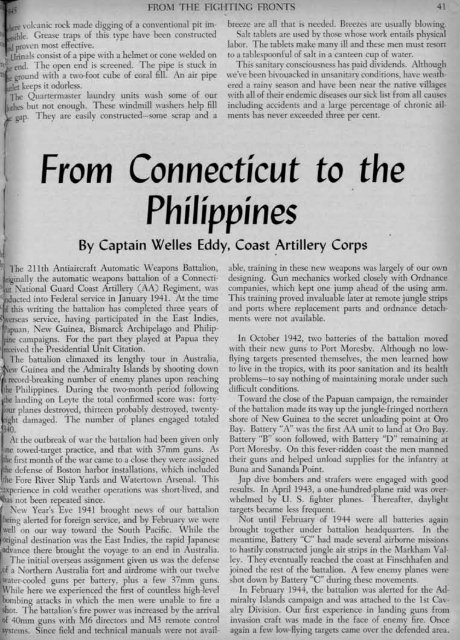September-October - Air Defense Artillery
September-October - Air Defense Artillery
September-October - Air Defense Artillery
You also want an ePaper? Increase the reach of your titles
YUMPU automatically turns print PDFs into web optimized ePapers that Google loves.
FROJ\I THE FIGHTI:\lG FRONTS<br />
:re ,'olcanic rock made diooino of a conventional pit im-<br />
00 0<br />
-ible. Grease traps of this type have been constructed<br />
proven most effective.<br />
Urinals consist of a pipe with a helmet or cone welded on<br />
end. The open end is screened. The pipe is stuck in<br />
ground with a two-foot cube of coral fill. An air pipe<br />
rl~tkeeps it odorless.<br />
The Quartermaster laundry units wash some of our<br />
Iothesbut not enough. These windmill washers help fill<br />
gap. They are easily constructed-some scrap and a<br />
breeze are all that is needed. Breezes are usually blowing.<br />
Salt tablets are used by those whose work entails physical<br />
labor. The tablets make manv ill and these men must resort<br />
to a tablespoonful of salt in a ~anteen cup of water.<br />
This sanitary consciousness has paid dividends. Although<br />
we've been bivouacked in unsanitarv conditions, have weathered<br />
a rainy season and have been' near the native villages<br />
with all of their endemic diseases our sick list from all causes<br />
including accidents and a large percentage of chronic ailments<br />
has never exceeded three per cent.<br />
l From Connecticut to the<br />
Philippines<br />
•<br />
l<br />
By Captain Welles Eddy, Coast ~rtillery Corps<br />
\tThe 21lth Antiaircraft Automatic \Veapons Battalion,<br />
riginally the automatic weapons battalion of a Connectit<br />
National Guard Coast <strong>Artillery</strong> (AA) Regiment, was<br />
ducted into Federal service in January 1941. At the time<br />
. f this writing the battalion has completed three years of<br />
rerseas service, having participated in the East Indies,<br />
-Papuan, New Guinea, Bismarck Archipelago and Philippinecampaigns.<br />
For the part they played at Papua they<br />
recei\'edthe Presidential Unit Citation.<br />
The battalion climaxed its lengthy tour in Australia,<br />
1 Ie\\' Guinea and the Admiralty Islands by shooting down<br />
record-breaking number of enemy planes upon reaching<br />
the Philippines. During the two-month period following<br />
he landing on Leyte the total confirmed score was: forty-<br />
'our planes destroyed, thirteen probably destroyed, twentyight<br />
damaged. The number of planes engaged totaled<br />
340.<br />
At the outbreak of war the battalion had been given only<br />
one towed-target practice, and that with 37mm guns. As<br />
thefirst month of the war came to a close they were assigned<br />
the defense of Boston harbor installations, which included<br />
the Fore River Ship Yards and \Vatertown Arsenal. This<br />
~xperiencein cold weather operations was short-lived, and<br />
as not been repeated since.<br />
New Year's Eve 1941 brought news of our battalion<br />
being alerted for foreign service, and by February we were<br />
\rell on our way toward the South Pacific. \Vhile the<br />
original destination was the East Indies, the rapid Japanese<br />
advance there brought the voyage to an end in Australia.<br />
The initial over~eas assignment given us was the defense<br />
of a Northern Australia fort and airdrome with our twelve<br />
\rater-cooled guns per battery, plus a few 37mm guns.<br />
While here we experienced the first of countless high-level<br />
bombing attacks in which the men were unable to fire a<br />
shot. The batt.alion's fire power was increased by the arrival<br />
of 40mm guns with M6 directors and M3 remote control<br />
systems. Since field and technical manuals were not avail-<br />
able, training in these new weapons was largely of our own<br />
designing. Gun mechanics worked closely with Ordnance<br />
companies, which kept one jump ahead of the using arm.<br />
This training proved invaluable later at remote jungle strips<br />
and ports where replacement parts and ordnance detachments<br />
were not available.<br />
In <strong>October</strong> 1942, two batteries of the battalion moved<br />
with their new guns to Port Moresby. Although no lowflying<br />
targets presented themselves, the men learned how<br />
to live in the tropics, with its poor sanitation and its health<br />
proble-ms-to say nothing of maintaining morale under such<br />
difficult conditions.<br />
Toward the close of the Papuan campaign, the remainder<br />
of the battalion made its way up the jungle-fringed northern<br />
shore of New Guinea to the secret unloading point at Oro<br />
Bay. Battery "A" was the first AA unit to land at Oro Bay.<br />
Battery "B" soon followed, with Battery "D" remaining at<br />
Port Moresby. On this fever-ridden coast the men manned<br />
their guns and helped unload supplies for the infantry at<br />
Buna and Sananda Point.<br />
Jap dive bombers and strafers were engaged with good<br />
results. In April 1943, a one-hundred-plane raid was overwhelmed<br />
by U. S. fighter planes. Thereafter, daylight<br />
targets became less frequent.<br />
Not until February of 1944 were all batteries again<br />
brought together under battalion headquarters. In the<br />
meantime, Battery "C" had made several airborne missions<br />
to hastily constructed jungle air strips in the Markham Valley.<br />
They eventually reached the coast at Finschhafen and<br />
joined the rest of the battalion. A few enemy planes were<br />
shot down by Battery "C" during these movements.<br />
In February 1944, the battalion was alerted for the Admiralty<br />
Islands campaign and was attached to the 1st Cavalry<br />
Division. Our first experience in landing guns from<br />
invasion craft was made in the face of enemy fire. Once<br />
again a few low-flying targets came over the defended area.<br />
41
















